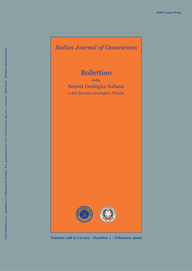Abstract
Seismic and outcrop data suggest that the Mesozoic carbonate successions cropping out in the Matese and Camposauro Groups, in the central-southern Apennines of peninsular Italy, can be interpreted as an exposed part of the Inner Apulia Platform (PAI). Cretaceous sequences have been studied in detail in the field and compared with the coeval carbonate sediments of the Inner Apulia Unit cored in the Benevento oilfield and in the Monte Taburno 1 and Morcone 1bis wells. Subsurface data show that, starting from the late Aptian time onwards, the Inner Apulia Platform was dismembered into a series of sub-domains which included shelfal productive areas and a series of small intra-platform basins (or elongated depressions). These basins have a mean Apennine orientation and were locally affected by significant subsidence.
Outcrop analyses indicate similar tectono-sedimentary trends and led to the recognition of three main structuring phases, that can be ascribed Middle Aptian, Late Aptian-Albian and Early-Middle Cenomanian time intervals, respectively. The main structural features, formed during the first structuring phase, were repeatedly reactivated during the subsequent phases and controlled the palaeo-environmental evolution of the various sub-domains, that were characterised by different facies and facies associations.
The facies analysis from integrated outcrop and core data shows analogous evolutionary trends. In particular, starting from the middle-late Aptian, the carbonate factories display a sharp variation in the sedimentary dynamics and depositional architectures: the uniform pre-Aptian shallow-lagoon rimmed system rapidly evolved into a much complex system in which shallow-water rudist-dominated carbonate factories were located alongside by-pass and deeper basinal areas. At outcrop, the steering toward open marine conditions can be correlated with the early (middle Aptian) structuring phase of the platform. This trend is marked in the easternmost studied areas by the formation of tectonically active margins, characterised by the presence of complex channel networks, but is also evident in the innermost sectors (western areas) of the shelves, by the increase in frequency and intensity of high-energy events.
The varied time-span of the «mid-Cretaceous» stratigraphic gaps (see CARANNANTE et alii, 1987, 1994; RUBERTI, 1992) supports the hypothesis of a complex tectonically-controlled palaeo-topography and of a differential evolution of the related sub-domains. Since the late Turonian, a shallow sea encroached on the exposed lands. Deposition of shallow water rudist-rich sediments followed. The peculiar features of the benthic assemblages which dwelled patchily in loose substrata resulted in the lack of real reefs at the shelf margins. This enhanced the water circulation and controlled the 3D arrangement of the sedimentary bodies made up mainly of large coalescing sheets of winnowed fine to coarse skeletal sands. The skeletal fraction, produced by intensive bio-erosive and mechanical processes acting on mainly diagenetically stable calcite-shelled organisms, covered most of the open shelf. This large amount of loose silt- to pebble-sized bio-clastic debris was periodically removed from the shelf, transported (often through submarine channels) and re-sedimented in the adjacent strongly subsiding intra-platform basins formed during the Lower Cretaceous and Cenomanian structuring phases.
Finally, the study of available seismic lines allowed for correlation between the Matese Mountains and the Morcone 1 well and the Benevento oilfield. These lines, tied to well data, show a complex structure formed by several thrusts where older units pertaining to the Apulia Platform are piled up over younger siliciclastic units of the Miocene Foredeep. Further, the foredeep siliciclastic deposits are as old as lower-middle Tortonian in the Eastern Matese, while as young as late Tortonian in the Morcone 1 well and Pliocene in the Benevento oilfield. This remarkable time-polarity appears to support the hypothesis presented in this contribution, and makes it possible to constrain the timing of the thrust emplacement for this sector of the Apennine Chain.
Keywords
Get Full Text
